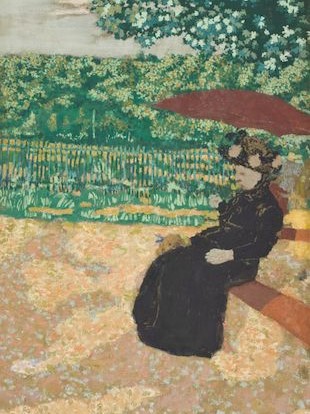One of the most obvious, but also the most useful, advantages of seeing the original, as opposed to a reproduction, of an art work is that you gain an immediate sense of its scale. The French painter Édouard Vuillard would often work on small, even tiny canvasses. But he was also comfortable with much larger spaces, and in the Musée d’Orsay in Paris the first of his works that you see are the three big panels that make up the picture called Les jardins publiques.

For a long time Vuillard was seen as the junior part of an artistic twosome, Bonnard-Vuillard. Pierre Bonnard received the bulk of critical attention, and of space on gallery walls. More recently Vuillard’s work, just as intimate as Bonnard’s and often more daring, has come into its own. Les jardins publiques combines both qualities, and repays close attention.
The three panels were commissioned in 1894, along with six other panels, by Alexandre Natanson, a Paris lawyer and publisher, for the living room of his home in the Avenue du Bois, now the Avenue Foch. They borrow their form from the medieval triptych (Vuillard greatly admired the tapestries he could see in the Musée de Cluny). Another influence was Japanese art. Vuillard shared with many of his contemporaries a love of Japanese prints, with their bold, decentred compositions and their flat surfaces. Japanese screens also offered a model for the connected panels. Vuillard’s subject is one very familiar from the work of Monet, Renoir and other Impressionists – the public garden: this one may be the Bois de Boulogne, close to the Natanson house.

Vuillard’s composition is as bold as any Japanese print. The lower half of the central panel, ‘La conversation’. is virtually empty – just the gravel surface of the park’s grounds, with diagonal splashes of light and shade – and the three seated women are wedged together in a close bunch at the centre-left of the field. The smaller panels to left and right are very different. The left one, ‘Les nourices’, is full of centripetal action: young children are at energetic play, under the watchful eye of nursemaids. In the right-hand panel, ‘L’ombrelle rouge’, there’s just one figure, a woman seated on a bench, shading herself with a parasol.

Look at the three women in the central panel and you’ll see that the skirt of the middle figure looks exactly as if it were a collage: the surface is entirely flat and could have been lifted direct from a fragment of textile or wallpaper. This small passage is just one example of how Vuillard denies volume and perspective to his scene – but without ever quite losing the human meaning he’s keen to retain. The whole picture radiates lightness and joy, but also hints at gossip and even the loneliness of old age, though with the minimum of detail (facial features are barely sketched in). It balances delicately a concern for formal complexity with a feeling for its subjects. Other works by Vuillard, especially the interior scenes for which he’s best known, keep this balance. Around the corner from Les jardins publiques are two tiny portraits of the same woman, Marthe Mellot, painted with extreme economy but, again, with intimate feeling.

A second advantage of seeing the original of Les jardins publiques is that you can see how it’s painted: not in oils, but in a glue-based distemper, that allows Vuillard to produce his flattened surfaces and muted colours (mainly beige, green and blue), and give them a matt finish.


Leave a Reply